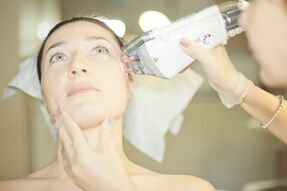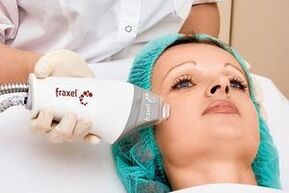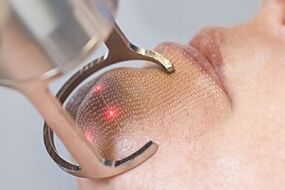
There are so many innovative techniques for protecting youth that patients sometimes get lost in their choices.
Those who want to activate the natural process of skin renewal and rejuvenation can be offered effective procedures such as fractional thermolysis, in which the top layer of the epidermis is removed with a laser grinder.
Fractional laser skin rejuvenation is one of the more effective types of cosmetic procedures that can combat age -related skin changes.
This method has its own characteristics and technology, indications and contraindications. Before implementing it, you must consult an expert.
Principles of technique

For the first time, fractional thermolysis technology was tested by American scientists in 2004. Since then, it has undergone many clinical studies and has become a powerful tool in the field of modern cosmetology. The essence of fractional thermolysis (photothermolysis, nanoperforation, fraxel) is that special tools are used to separate the laser beam into many ultra fractions.
The procedure involves the use of a very small and targeted laser beam, resulting in microscopic damage to the treated skin area.
Laser irradiation increases the local temperature of each skin area, which inevitably results in heating of the intracellular contents and destruction of the cell structure. In turn, this activates the recovery process, leading to increased production of fibrillar proteins (collagen) and the formation of new epithelial cells. And the more collagen in the epidermal layer, the less wrinkles and other blemishes on the skin.
With regard to molecular changes, here it should be noted the emergence of heat shock proteins, hyaluronic acid and the emergence of variable growth factors (special polypeptides). All of these substances accelerate the utilization of damaged collagen from cells and form new molecules.
The surface layer of the skin, as a rule, is restored on the second day after cosmetic manipulation. Exfoliation of dead cells ends in about 10 to 12 days.
In each damaged area, intensive recovery begins, as nature provides a high regrowth rate for skin tissue. Thanks to its core effect, a fairly dense supply of healthy cells is formed in the skin, which serves as a source of new epithelial cells.
Ablative and non -ablative technologies
When a laser pulse is used to evaporate the active substance, it is most likely laser ablation. In ablative photermolysis, laser radiation is used, the energy of which is mostly accumulated by water molecules. By acting briefly on a local area, the laser flow immediately increases the temperature of the water contained in the tissue to 300 degrees. At the site of evaporation, open wounds of small size appear, adjacent to thermally accumulated epithelial cells.
Such thermolysis requires a longer recovery time than non -ablative technologies, but the results will look even greater. The disadvantage of this method, perhaps, can only be attributed to the fact that there is a certain risk of infection of the tissues of the inner lining of the skin.
Non-ablative thermolysis is considered a less traumatic procedure. Here, a laser beam is used, which practically reduces the risk of damage to the epidermis to zero - burns form underneath. The destroyed epithelial cells do not evaporate, but settle in the dermis, therefore, the patient does not have to face an open wound. Tightening and rejuvenation are not as obvious as other methods, as dead skin cells do not disappear anywhere, which means that the effect of tightening is minimal.
In contrast to the ablation technique, the patient is insured against infection of the skin tissue, because during the procedure the integrity of the surface layer of the skin is not disturbed.
Positive and negative sides
Like plastic correction, fractional thermolysis makes the skin less rough and rough. But if surgery is considered a radical way to improve the appearance of the skin, then thermolysis is referred to as gentle. Even so, its effectiveness is no less impressive. Moreover, the range of tasks solved by fractional thermolysis is even wider than that of contour plastics.

The main advantages of this technique are as follows:
- recovery occurs as soon as possible;
- during the procedure, the patient does not experience a painful sensation;
- the result is preserved for a long time;
- laser exposure is completely harmless for any skin type;
- even the most sensitive parts of the skin respond well to lasers;
- lack of strict restrictions during the recovery period;
- minimum number of side effects;
- the risk of blood poisoning with any virus (HIV, hepatitis) is zero.
Although thermolysis is considered a high -tech and safe method, it has its own side effects, in particular:
- penetration of microbial agents through the skin - staphylococci and streptococci;
- abnormal redness of the skin;
- inflammation and accumulation of fluid in the treated skin area;
- the appearance of hyperpigmentation, burns and small cracks, acne.
Indications and contraindications
A large number of customers are women of the older generation who want to clean wrinkles and get rid of simple folds on the face and neck. Of course, the effect will meet all expectations, but, in addition, this procedure allows you to solve other cosmetic problems, including:

- removal of pigmentation, age spots and marks formed due to the influence of sunlight;
- even out the signs of skin aging;
- smoothing deep wrinkles;
- pore narrowing;
- removal of small wrinkles on the eyelids;
- the return of lost elasticity to the epidermis;
- elimination due to acne;
- eliminates the effects of stretch marks and scars.
In some cases, patients are forced to seek alternatives to fractional thermolysis, as laser rejuvenation can lead to completely opposite results. Therefore, this procedure is contraindicated in the following cases:
- while carrying a child;
- during the lactation period;
- with an increase in existing disease;
- with acute respiratory infections, including influenza;
- in the presence of malignant neoplasms;
- if the patient has poor blood clotting;
- when the face is covered with many moles;
- if there is a focus of inflammation on the skin;
- in the presence of autoimmune diseases;
- if the patient is undergoing treatment with certain medications.
Procedure technology

Preliminary consultation with a cosmetologist is a mandatory stage in every cosmetic procedure, where the purpose of the doctor is to clarify the wishes of the client and provide information on the various nuances.
First of all, the cosmetologist treats the patient’s skin using a cotton pad with an anesthetic cream applied to it. Then the ointment is applied to the surface of the skin to facilitate sliding of the tool.
After that, armed with tools with additional tools, the specialist continues treatment to the problem area. The anesthetic applied and the cool airflow minimize the sensation of pain, creating additional comfort for the patient. Patients, with rare exceptions, may complain of a slight tingling sensation.
The Fraxel device, developed by American scientists, is making a splash in the field of non -invasive cosmetology. Specialists get a unique opportunity to perform laser thermolysis using special nozzles for each specific purpose. In some preparations, only thulium stems are involved, while in others, erbium stems, there are also combined models. Depending on which area of skin is to be processed, one or the other core is selected.
The entire session rarely lasted more than thirty minutes. If you need to get rid of the effects of stretching on your hips and abdomen, it may take longer.
The original Fraxel device had 4 main modes, each allowing a laser beam to penetrate to a certain depth:
- Good. Soft surface treatment. Ideal for working with eyelids, breasts and other sensitive areas of the body.
- Repairs. The thulium stem provides deep penetration of the laser beam into the skin, which makes it possible to remove wrinkles and deep marks and regulate itching on the skin. If there is vascular dysromia, narrowing of pores, then such rehabilitation is the best option.
- Restore. The most popular technique today, which allows you to forget about superficial wrinkles and small scars after acne.
- Restore Dual. This procedure is performed with the use of two stems simultaneously - erbium and thulium. It will help those who suffer from scars and scars.
How many sessions are needed to achieve a significant effect depends on the severity of the lesion and the specifics of the area being treated, but usually at least 5-7 procedures are performed.
Characteristics of the recovery period
After fractional thermolysis, the skin requires special care, especially in the early times. Restoring the mask will not be superfluous. The face must always be lubricated with a nourishing and moisturizing cream.

To maintain the achieved effect, it is very important to follow the simple advice of a doctor:
- for the first three days, excluding physical activity;
- do not visit baths and saunas, and also do not take hot showers for a month;
- refuse cosmetic procedures for a month, including exfoliation;
- limit the time spent in the sun, because excessive ultraviolet radiation is twice as harmful to newly restored skin;
- during recovery, stop drinking alcohol and smoking.
After the procedure, some patients notice swelling and redness on their skin. This should not be scary, after a few days, once the redness is gone, you need to see a beautician so that he can evaluate the results of therapy.
Issue price
Laser correction, indeed, is not a cheap procedure. The cost of fractional thermolysis varies depending on the prestige of the clinic, the amount of work done, the price of consumables, and so on. Thermolysis of the face and neck will cost less than similar manipulations performed on the abdomen, buttocks and other body parts.
Modern cosmetology has not stopped, but the controversy over the possibility of the use of lasers in this area has not subsided until now. Anyone who says anything - fractional laser thermolysis deserves to be recognized as one of the safest and most effective procedures.














